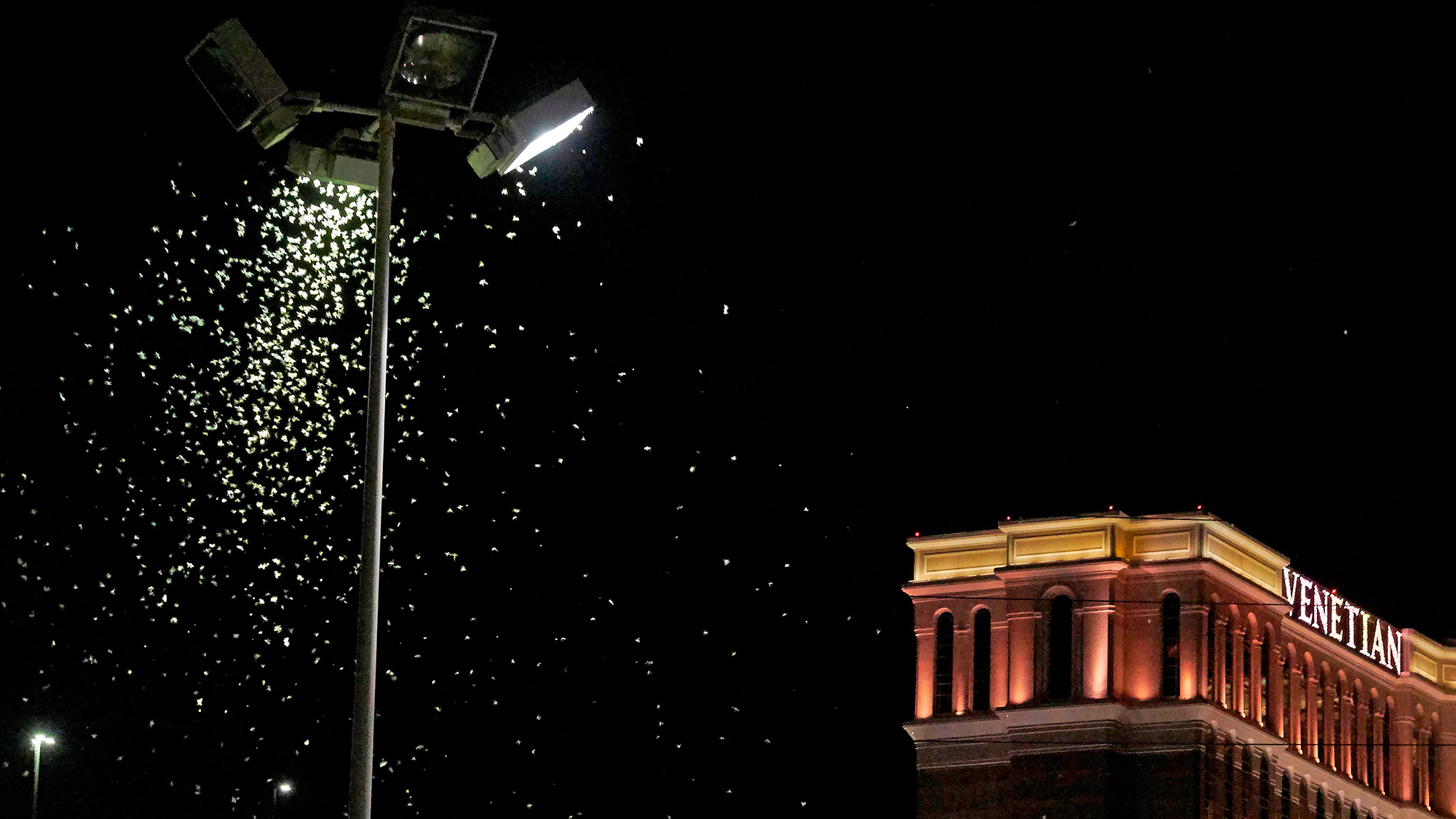'Living Snow' of Grasshoppers Blankets Las Vegas, Visible on Radar

Here are five words you definitely don't want to hear: "It's not snowing. It's grasshoppers."
But over the past few days, that's been the nightmarish scene in Las Vegas. The city's bustling, casino-lined Strip is even busier than usual, literally swarming with grasshoppers that blanketed sidewalks and seethed around lights.
The pallid-winged grasshopper (Trimerotropis pallidipennis) is a common desert species in southwestern parts of the United States. And after a rainy winter and spring that provided the insects with a feast of rich vegetation, multitudes of grasshoppers that originated in southern Nevada are on the move and migrating north. Their path carries them right through Las Vegas and could extend into central Nevada, U.S. Department of Agriculture (USDA) entomologist Jeff Knight told reporters on July 25. [Top 10: Nature's Biggest Pests]
Similar grasshopper migrations have followed wet winters or springs in the past, Knight said; he recalled seeing such events in the region "at least four or five times" over the course of a career that has spanned more than three decades. Once grasshopper populations grow to a certain density, an increase in the chemical serotonin secreted by the insects may trigger swarming behavior, leading the insects to collectively take flight.
The creatures fly at night and can cover "a couple hundred miles, at least," Knight said, and during their migration northward, they fly at altitudes of up to 1,000 feet (305 meters). This particular swarm is so dense that on July 27 it was picked up by radar that meteorologists use to track the weather: At first glance, the large clusters of insects resembled storm clouds, CNN reported.
Pallid-winged grasshoppers have tan- or grey-patterned bodies with distinctive black-and-yellow bands on their legs, and they can be found in dry habitats from southwestern Canada to Argentina. The size of the insects varies depending on where they live, and females are larger than males, measuring up to 1.3 inches (33 millimeters) in length, according to the USDA.
But while individual grasshoppers may be small, the sheer number of them in the Las Vegas swarm is unsettling. One witness tweeted a video of a grasshopper tornado whirling around a streetlight outside the Flamingo Las Vegas hotel on July 26. She remarked in the tweet that the dense clouds of winged bodies resembled a living "snow" of flying insects.
Sign up for the Live Science daily newsletter now
Get the world’s most fascinating discoveries delivered straight to your inbox.
In 1988, a swarm of pallid-winged grasshoppers in Arizona was so numerous that the masses of insects in the streets reached depths of 2 inches (5 centimeters), the USDA reported.
Because there are currently so many grasshoppers arriving in Las Vegas, trying to get rid of them with pesticides would be pointless — regardless of how many are killed on any given night, another wave with thousands more would quickly take their place the next time the sun goes down, Knight said. Plenty of the insect invaders will end up being eaten by birds, coyotes and even by other insects, Knight said.
What's more, residents have nothing to fear from the grasshopper visitors.
"They don't carry any diseases, they don't bite, they're not even one of the species that we consider [to be] a problem," Knight told reporters.
And what if the grasshoppers manage to get inside a home? "Use a vacuum cleaner," Knight said. "There's no point in spraying your house."
As the saying goes: What happens in Vegas stays in Vegas. But fortunately for the city's human inhabitants, these quantities of flying insects aren't there to stay, and the grasshoppers should be gone within a couple of weeks "at the most," Knight said.
- Image Gallery: Striking Photos of Locust Swarms
- Photos: 15 Insects and Spiders That May Share Your Home
- 7 Insects You'll Be Eating in the Future
Originally published on Live Science.

Mindy Weisberger is an editor at Scholastic and a former Live Science channel editor and senior writer. She has reported on general science, covering climate change, paleontology, biology and space. Mindy studied film at Columbia University; prior to Live Science she produced, wrote and directed media for the American Museum of Natural History in New York City. Her videos about dinosaurs, astrophysics, biodiversity and evolution appear in museums and science centers worldwide, earning awards such as the CINE Golden Eagle and the Communicator Award of Excellence. Her writing has also appeared in Scientific American, The Washington Post and How It Works Magazine. Her book "Rise of the Zombie Bugs: The Surprising Science of Parasitic Mind Control" will be published in spring 2025 by Johns Hopkins University Press.









